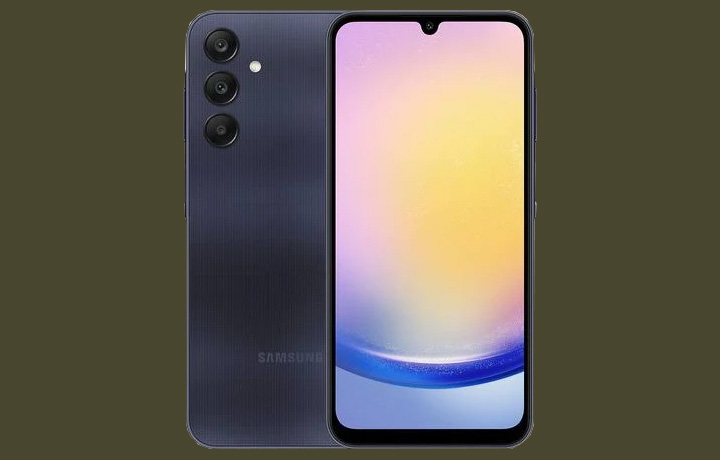Samsung Galaxy A25 Review: A Value-Packed Mid-Range Contender
Samsung’s Galaxy A series has been a consistent player in the mid-range smartphone market, providing users with a blend of affordability and features. The Galaxy A25, the latest addition to the A20 family, aims to continue this tradition with significant upgrades.
In this comprehensive review, we’ll delve into the design, display, performance, camera capabilities, and overall user experience to determine if the Galaxy A25 is a competitive choice in the crowded mid-range smartphone segment.
Design and Build:
The Galaxy A25 maintains the familiar design language of its predecessor, the A24. The phone features a flat plastic back with a fine checkered pattern, and the middle plastic frame has been subtly redesigned around the power button and volume keys. While it may not boast the premium feel of more expensive Galaxy A series phones, the design improvements contribute to a slightly more refined aesthetic.
However, a notable omission is the lack of official Ingress Protection, a standard feature in higher-end models. Potential buyers should be aware that the A25 does not offer water and dust resistance.
Display:
The Galaxy A25 sports a 6.5-inch OLED display with a 1080p resolution. One of the significant upgrades is the inclusion of a faster 120Hz refresh rate, enhancing the overall user experience by providing smoother swiping and scrolling compared to the previous 90Hz panel.
Although the refresh rate isn’t adaptive, potentially impacting battery life, the display delivers sharp and contrasty visuals. The bezels, while expectedly larger on a budget phone, don’t hinder the A25’s impressive maximum brightness, measuring around 430 nits and exceeding 1,000 nits in auto mode under bright sunlight.
Audio Features:
Audio enthusiasts will appreciate the inclusion of a headphone jack and stereo speakers, a notable improvement over the A24’s single speaker setup. The stereo speakers deliver impressive loudness and rich sound quality, with clear highs and even some bass presence.
Fingerprint Reader and Storage Options:
The A25 features a side-mounted capacitive fingerprint reader integrated with the power button. The fingerprint reader is accurate and responsive, adding an extra layer of convenience for users. Storage options include 128GB and 256GB onboard storage, expandable via microSD, offering ample space for multimedia content and apps.
Software and Updates:
Running on Android 14 with Samsung’s One UI 6 overlay, the Galaxy A25 provides a full-featured user experience. The interface is visually and functionally similar to its predecessor, with notable changes in button layout on the quick panel and improved notification management. Samsung promises four major OS updates and five years of security patches for the A25, ensuring longevity in terms of software support.
- Read more:
- Garmin Epix Pro Review
- Garmin Fenix 7 Pro Review
- Motorola Launches Moto G Stylus 5G (2023) with Impressive Features
Performance:
The Galaxy A25 is powered by the Exynos 1280 chipset, a 5G-capable processor previously seen in the Galaxy A53 5G and A33 5G. In benchmark tests, the A25 demonstrates commendable performance within its price range, outperforming competitors with Snapdragon 695 or Snapdragon 4 gen 1 CPUs. Everyday tasks and casual gaming are handled with ease, thanks to the capable hardware.
Battery Endurance and Charging:
Equipped with a 5,000mAh battery, the A25 provides satisfactory battery life, earning an active use score of 10 hours and 19 minutes. However, improvements could be made in web browsing and gaming endurance.
The A25 supports 25W charging, but disappointingly, there’s no charger included in the box. With the proper adapter, the phone charges from 0 to 49% in half an hour and reaches a full charge in 84 minutes.
Camera Capabilities:
The camera setup on the Galaxy A25 includes a 50MP main camera, an 8MP ultra-wide camera, and a 2MP macro shooter. While the main camera produces photos with good contrast and dynamic range, it tends to be soft when zoomed in closely. Portrait shots are decent, with accurate edge detection. In low-light conditions, the main camera’s performance is average, with some softness and noise present.
The 8MP ultra-wide camera is an improvement over the previous model but falls short of delivering outstanding results. Photos are soft, with aggressive sharpening, and low-light performance remains underwhelming even with the dedicated night mode.
The 2MP macro camera produces usable close-ups with good colors and dynamic range, but the level of detail is not particularly impressive. Selfies, taken with the 13MP front-facing camera, are a highlight, offering accurate colors and plenty of detail.
Video recording capabilities include 4K video capture with good detail and vibrant colors. The A25 features gyro-based electronic image stabilization for smoother footage, though limited to 1080p resolution.
- See also:
- What’s New In WatchOS 10
- Poco F5 Pro Review: Moving into Flagship Territory
- Google Pixel 7A Review – A Mid-Range Phone with Impressive Camera!
Conclusion:
In conclusion, the Samsung Galaxy A25 stands out as a solid mid-range option, offering a range of upgrades over its predecessor. The inclusion of 5G connectivity, a higher refresh rate display, stereo speakers, and 4K video recording enhances its value proposition. While the design is in line with budget expectations, the lack of official Ingress Protection and the camera’s performance in low-light scenarios are notable drawbacks.
For users seeking a reliable mid-range device with a competitive feature set, the Galaxy A25 is worth considering. The promise of four major OS updates and five years of security patches adds to its appeal, ensuring a more extended lifespan in the rapidly evolving smartphone landscape. Overall, the Galaxy A25 positions itself as a compelling option for the average buyer in the mid-range smartphone market.
- Shop On Amazon Using Our Links To Support Us:
- Amazon under $25 – Amazon best sellers – Amazon most gifted










